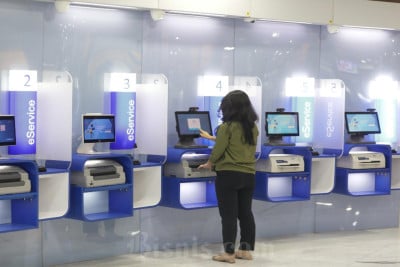JAKARTA: Banks with low funding costs, with a lot of 'demand deposit' and savings accounts on their book, tend to offer low prime lending rates to borrowing customers. Low prime lending rates are being offered by those banks with the ability to tap such cheap funding, including PT Bank Central Asia Tbk, PT Bank Pembangunan Daerah Jawa Timur, dan PT Bank Pembangunan Daerah Kalimantan Timur. Demand deposit, or called rekening giro, and savings accounts allow customers to enjoy more service and features, but the interest rate is typically lower than other products like time-deposits. These three banks offer a prime lending rate of 9%, 9.18%, and 9.3% respectively, to their borrowing clients. As a comparison, Bank Mutiara whose majority third party funds are time-deposits offers a 13% prime lending rate. BCA is widely known for its ability to raise savings funds through its 'Tahapan' product. As per March 2011, the portion of BCAs low interest bearing third-party funds is more than of its total IDR275.83 trillion third party funds.
About 73.5%, of Bank Jatim's IDR16.58 trillion third-party funds, are demand deposit and savings accounts. The more demand deposit accounts a bank has on its book, the more efficient it will become.
Referring to Bisnis Indonesias data on prime lending rate, 14 out of 37 banks have not revised their prime lending rate since the regulation was first imposed on 31 March 2011. Banks ideally renew the rate on June 30, or once every three months. Fifteen banks updated their prime lending rate as per June 30 and July 1, while the remaining banks revised their publication in April and May. When updating, they either raise, lower or maintain the rate. BCA in fact is among banks that maintain their prime lending rate for all corporate credit at 9%, while retail credit at 11%, mortgage credit at 9.5%, non mortgage credit at 10.05%. Similarly with PT Bank OCBC NISP Tbk. BCA President Director Jahja Setiaatmadja said that BCAs rate is somehow lower compared to other banks because it has been revised like other banks' rates. BCAs prime lending rate does not rise. This is why our rate is the lowest. We are not raising it because our cost of fund also has not risen, he said.
Jahja cannot promise whether it will raise the prime lending rate until the end of this year.
PT Bank Rakyat Indonesia raised the rate for corporate credit to 11.1% from 10.68%, while retail credit rate rose to 13.31% from 12.86%. The rate of mortgage credit increased to 11.91% from 11.49% and non mortgage credit rate ascended to 13.59% from 11.15%. PT Bank Permata Tbk also raised its corporate leding rate from 10.75% to 11%. This measure was taken due to rising interest expenses caused by rising cost of funds. Bank Mega needed to increase the lending rate since the portion of savings and demand deposit accounts declined to 52% of the total third partys fund at IDR39 trillion, said President Director JB Kendarto. Earlier, the ratio of low cost to high cost fund was 55:45, now it is 52:48. As of March, Bank Mega set the prime lending rate for corporate borrowers at 11.75%, for retail at 17.75%, for house ownership credit at 12.5%, and for consumer non-house ownership at 12.75%. PT Bank Jabar Banten Tbk reduced its prime lending rate for retail to 12.27% from 19.24$ and for non-house ownership to 11.15% from 16.38%. Meanwhile, it increased the rate for corporation to 9.89 from 9.2% and for house-ownership to 9.55% from 8.73%. Bank Mizuho Indonesia offers the lowest rate for corporate clients at 7.5%, while PT Bank Tabungan Pensiunan Tbk has the highest rate for retail at 21.8% and for non-house ownership at 20.8%. Customers access Bank Indonesia Deputy Governor Muliaman D. Hadad said customers' access to information on banks' prime lending rate is not enough, so publishing the rates is necessary to make people aware in choosing a competitive interest rate. Customers are advised to pay attention to the prime lending rate level, announced by banks every three months. This way, customers will help foster the competition between banks and will give a positive impact to the lowering of lending rates. I fear that there are only a few people visiting banks' websites. If they want to find out [about the lending rate], they go to banks and it takes time, Muliaman said. The central bank, he added, will look how much people make use of the information on the prime lending rate. Without people's awareness, healthy competition between banks would be difficult to happen. Competition will increase if there is more disclosure. We expect it will improve the efficiency of national banking industry, he added. Prime lending rate will force banks to be more transparent in setting their lending rate, said economist Cides Umar Juoro. However, he added, the prime lending rate has not given a significant effect in improving banks' efficiency as most customers have not used the information yet.
Moreover, the prime lending rate is considered as a good step to improve banks, said Drajad H. Wibowo, an economist at Sustainable Development Indonesia. Banks need support. Though I dont think the publication gives a big impact to the market in reducing interest spread, it can improve transparency. Bank Indonesia Governor Darmin Nasution admitted that there were still banks that did not accurately complete the data on their prime lending rate, creating a wide disparity in loan rates between one segment to another. Thus, he continued, the central bank will call banks to complete and update the data. Within two months we will make improvement. Then the benchmark will be set after it becomes accurate. (T02/T04)















